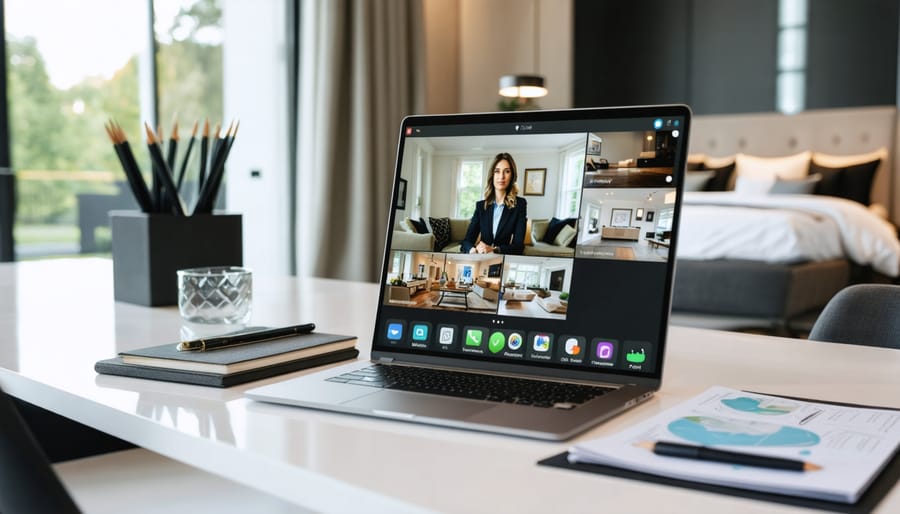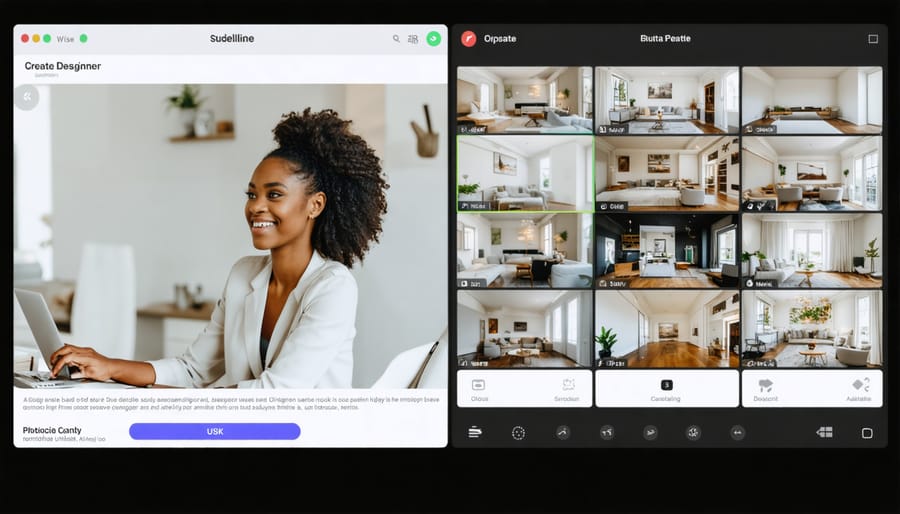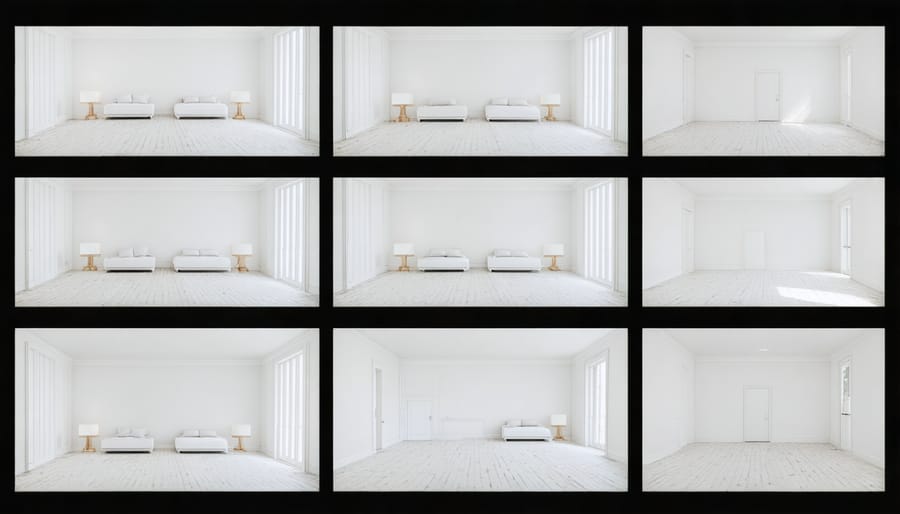
Transform Your Space: Virtual Design Consultations That Actually Work
Transform your living space without leaving your home through virtual interior design consultations – a revolutionary approach that brings professional design expertise directly to your screen. In today’s digital age, homeowners can now collaborate with experienced designers through video calls, 3D visualization tools, and virtual mockups to create their dream spaces. This innovative service combines the convenience of remote interaction with the personalized attention of traditional design consultations, making professional interior design accessible to everyone, regardless of location or schedule constraints.
Whether you’re planning a complete home makeover or seeking advice for a single room refresh, virtual consultations offer the flexibility and efficiency modern homeowners need. With just a smartphone camera, basic measurements, and an internet connection, you can receive expert guidance, custom design plans, and detailed recommendations tailored to your style, budget, and space requirements. The process is streamlined, cost-effective, and delivers professional results while maintaining the personal touch that makes interior design transformative.
How Virtual Interior Design Consultations Work

Essential Tools and Technology
To get started with virtual interior design consultations, you’ll need a few essential tools and technologies. A reliable computer, tablet, or smartphone with a high-quality camera is fundamental. Make sure your device has a good internet connection and sufficient storage space for design apps and photos.
Key software includes video conferencing platforms like Zoom, Skype, or FaceTime for live consultations. You’ll also want a cloud storage solution like Google Drive or Dropbox to share photos and documents with your designer easily. For taking measurements and creating floor plans, apps like Magicplan or RoomScan Pro are invaluable tools.
Photography apps with good lighting adjustment features help capture accurate room colors and details. Consider downloading basic photo editing software to mark up images or highlight specific areas you want to discuss. Some designers might request you to use specific design visualization apps like Homestyler or RoomPlanner, which allow for 3D room modeling.
Don’t forget basic measuring tools like a tape measure and a smartphone level app. These physical and digital tools working together ensure your virtual consultation runs smoothly and produces accurate results.
The Virtual Consultation Process
A virtual interior design consultation typically begins with scheduling your session and receiving a pre-consultation questionnaire. You’ll share your goals, budget, and design preferences, helping your designer prepare for the meeting. Before the consultation, you’ll need to take measurements and photos of your space from multiple angles, including close-ups of existing furniture and architectural features.
During the video call, your designer will walk through your space virtually as you use your smartphone or tablet to show different areas. They’ll ask questions about your lifestyle, discuss your vision, and provide real-time suggestions. The designer might use screen sharing to show you inspiration images, product recommendations, or quick sketches of potential layouts.
Following the consultation, you’ll receive a detailed summary of the discussion, including specific recommendations, product suggestions, and a basic action plan. Many designers also provide follow-up support through email or messaging platforms to answer questions as you implement their suggestions. The entire process is designed to be convenient and efficient, typically lasting 60-90 minutes for the main consultation.
For best results, ensure you have a stable internet connection and good lighting during the video call. This helps your designer see your space clearly and provide the most accurate recommendations.
Preparing for Your Virtual Design Session
Space Documentation Tips
To get the most from your virtual interior design consultation, proper documentation of your space is essential. Start by taking clear, well-lit photos of your room from multiple angles. Stand in each corner and capture the entire space, including windows, doors, and any architectural features. Make sure to photograph during daylight hours with all lights on to ensure optimal visibility.
When measuring your space, create a basic floor plan using these steps:
1. Measure the length and width of each wall
2. Note window and door locations with their dimensions
3. Measure the ceiling height
4. Record the location of electrical outlets and light fixtures
5. Document any built-in features or obstacles
Take close-up photos of specific areas needing attention, like problem corners or storage challenges. For furniture and decor you plan to keep, photograph them individually and note their dimensions. Don’t forget to capture baseboard styles, trim details, and any unique architectural elements.
If possible, shoot a quick video walking through the space – this gives designers an excellent sense of flow and spatial relationships. Finally, document any permanent fixtures like radiators or air vents that can’t be moved, as these will impact the design possibilities.
Remember to share any inspiration photos or specific style preferences during your consultation to help your designer understand your vision.

Creating Your Design Brief
Creating a detailed design brief is your first step toward a successful virtual interior design consultation. Start by completing a comprehensive design brief questionnaire that outlines your vision, preferences, and practical requirements.
Take clear photos of your space from multiple angles, including corners, windows, and any architectural features. Measure your room dimensions accurately, noting doorways, windows, and any fixed elements. Create a simple floor plan sketch, marking electrical outlets and lighting fixtures.
Collect inspiration images that reflect your desired style, color schemes, and atmosphere. These could be from magazines, Pinterest boards, or Instagram saves. Be specific about what you like in each reference – is it the color palette, furniture arrangement, or overall mood?
Include practical considerations like your budget, timeline, and any non-negotiable elements you want to keep. Mention specific challenges you’d like to address, such as storage solutions or multi-functional spaces. Don’t forget to list your lifestyle needs – pets, children, work-from-home requirements, or entertaining habits.
The more detailed your brief, the better equipped your designer will be to create a space that truly reflects your vision and meets your needs.
Making the Most of Virtual Design Services
Communication Best Practices
Clear communication is the backbone of a successful virtual interior design consultation. Start by establishing your preferred communication method with your designer, whether it’s video calls, email, or messaging platforms. Before your consultation, prepare a detailed brief outlining your vision, preferences, and any specific concerns you want to address.
During video calls, ensure you have a stable internet connection and good lighting. Position your camera to provide comprehensive views of the space you’re discussing. When describing specific areas or items, use clear directional language like “to the left of the window” rather than vague terms like “over there.”
Take detailed notes during your consultation and don’t hesitate to ask for clarification. If your designer uses industry-specific terms you’re not familiar with, ask them to explain. Share reference images of styles you like and dislike to ensure you’re both on the same page visually.
When communicating measurements or technical details, double-check your numbers and use consistent units. Share photos from multiple angles, including close-ups of important features and wide shots of entire rooms. If possible, create a shared digital folder for exchanging images, documents, and inspiration boards.
Remember to provide timely responses to your designer’s questions and be specific about your feedback. This helps maintain project momentum and ensures your final design aligns with your vision.
Implementing Design Recommendations
Turning your virtual design consultation into reality requires careful organization and systematic implementation. Start by breaking down the designer’s recommendations into manageable phases while planning your home transformation. Create a detailed checklist of items to purchase, tasks to complete, and any necessary contractor appointments.
Use your consultation summary as a guideline and track your design progress with photos and notes. Begin with the larger elements like furniture placement and wall colors before moving on to smaller details like accessories and artwork. If your designer provided a mood board, reference it frequently to ensure your choices align with the intended aesthetic.
Take advantage of paint samples and fabric swatches before making final decisions. Many retailers offer free samples, which can help you verify colors and textures in your space’s actual lighting. When ordering furniture or decor, always double-check measurements and doorway clearances to avoid costly returns.
Don’t feel pressured to implement everything at once. Most designers structure their recommendations to work in phases, allowing you to spread out both the work and the expense. Keep communication channels open with your designer for any follow-up questions or clarification needed during the implementation process.
Virtual vs. Traditional Consultations
While both virtual and traditional interior design consultations aim to transform your space, each approach offers distinct advantages. Virtual consultations provide unmatched convenience and flexibility, allowing you to connect with designers from anywhere in the world at times that suit your schedule. They’re typically more cost-effective since designers don’t need to factor in travel time and expenses, and you can easily share inspiration, photos, and measurements through digital platforms.
Traditional in-person consultations offer the benefit of tactile experiences – touching fabrics, seeing true paint colors, and experiencing the space’s energy firsthand. Designers can notice subtle details about lighting, architecture, and flow that might be harder to capture through video or photos. However, they require coordinating schedules and usually come with higher fees.
Virtual consultations excel in efficiency, often allowing for quicker turnaround times and easier document sharing. You can record sessions for future reference and instantly share updates or questions through messaging platforms. While you’ll need to be more hands-on with measurements and photos, this involvement often leads to a better understanding of your space.
The choice between virtual and traditional ultimately depends on your comfort with technology, project complexity, and personal preferences. Many homeowners find that virtual consultations provide the perfect balance of professional guidance and DIY involvement, while others prefer the traditional touch-and-feel approach.

Virtual interior design consultations have revolutionized the way we transform our living spaces, offering a perfect blend of professional expertise and modern convenience. By eliminating geographical barriers and reducing costs, these services make professional design guidance accessible to more homeowners than ever before. Whether you’re looking to refresh a single room or redesign your entire home, virtual consultations provide the flexibility and personalized attention you need to achieve your design goals. Remember to prepare adequately by gathering measurements, photos, and inspiration pieces, and don’t hesitate to ask questions during your consultation. With the right preparation and an open mind, you can leverage virtual design services to create the beautiful, functional space you’ve always dreamed of – all from the comfort of your home.
